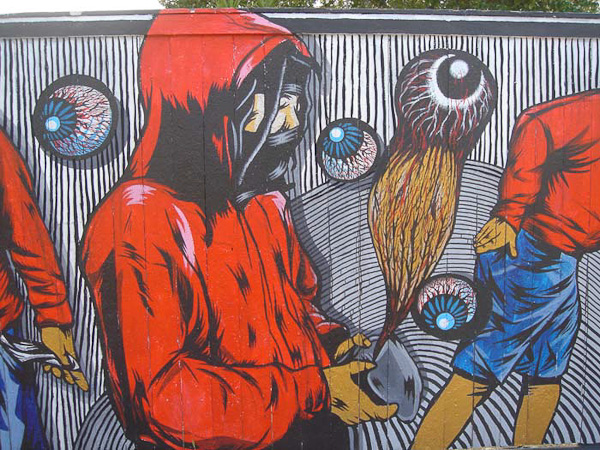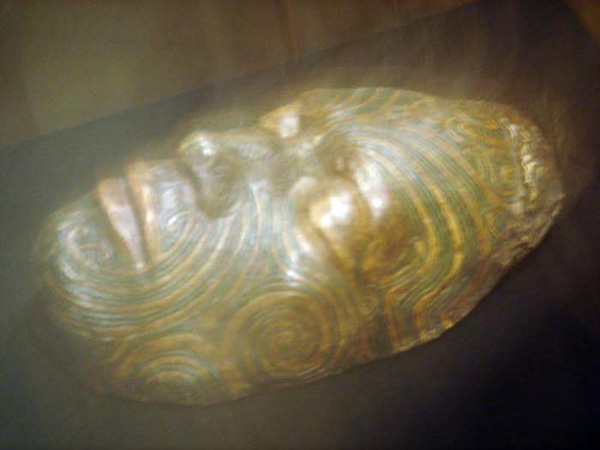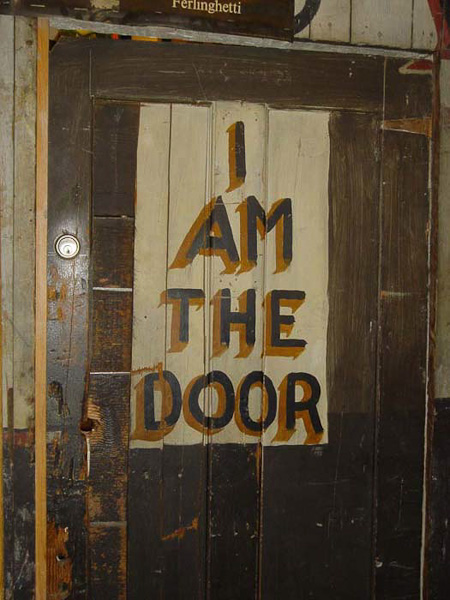So, cool, I got a passing mention in the Sunday New York Times Magazine today in an article by Rob Walker, “Cyberspace When You’re Dead,” about various kinds of digital immortality.

[The illos in today’s post, for reasons which will become clear, are my photos used to illustrate a story by Mac Tonnies, “One Hundred Years” which appeared in issue #3 of my online zine, Flurb. Some of the photos are from other stories in the same issue #3. By the way, I’d love to know the name of the artist who painted the wonderful street mural shown above.]
As regular readers will know, I’ve written about themes of software immortality in several contexts. To start with, the four novels in my Ware Tetralogy deal with the notion of copying someone’s mind to another platform. The collection is available in print, as a commercial ebook, and as a free CC ebook.

I coined the word “lifebox” in a short story, “Soft Death,” which appeared in The Magazine of Fantasy and Science Fiction in September, 1986. I used it to mean a digital or online simulacrum of a person. I go into considerable detail about the lifebox in my novel, Saucer Wisdom, in my non-fiction book, The Lifebox, the Seashell, and the Soul, and in my 2009 article “Lifebox Immortality” which I co-authored with Leon Marvell. This article has also appeared in a recent issue of h+ magazine.
In a nutshell, my idea is this: to create a virtual self, all I need to do is to (1) Place a very large amount of text online in the form of articles, books, and blog posts, (2) Provide a search box for accessing this data base, and (3) Provide a nice user interface.
I made a first crude stab at this a month ago, with my Rudy’s Lifebox page. This page lets you Google-search my rather large www.rudyrucker.com site.

The “test subject zero” discussed in today’s Times magazine article is Mac Tonnies, who died this year. I was one of Mac’s numerous online friends—you can find the exact extent of this by typing “Mac Tonnies” into the Search box on the Rudy’s Lifebox page mentioned above. Most of the hits are to posts which have comments by Mac at the bottom. And, as mentioned in the caption to first illo on today’s post, I published one of Mac’s stories in my webzine.
As the Times article discusses, some friends of Mac’s have kept his Posthuman Blues blog alive as a kind of lifebox. Note the slightly ominous final post, although Mac liked these kinds of images, so really they aren’t all that ominous in the context of his blog.
The Times article is a harbinger of a trend I’ve been predicting for some time: there’s going to be a small industry based on people building digital memory-shrines for themselves. The Nokia phone company had an early entry into this sweepstakes with their Lifeblog package, but that’s gone now, so far as I know. More recently, I noticed that Hallmark Cards is getting into “memory-keeping products.” And everyone’s heard of Microsoft’s Gordon Bell and his MyLifeBits project.

Some of the links in the Times article are for companies like Entrustet that serve as digital repositories for your “lifebox” data such as online photos or collections of your writings. At this point, some of these services are primarily about cloud-based data-storage, with an immortality spin. These services are expensive, though, and often involve a monthly fee—which you’re likely to stop paying a few years before you die. If you’re interested in pursuing a lifebox plan of your own, here’s a 2016 overview by a group called Cloudwards, comparing the various cloud-based storage services such as Carbonite.
Another company, Deathswitch, will send post-mortem messages to people from you! How do they know when to send the messages? When you stop answering their emails and/or, presumably, when paying the bills they send you. It’s easy to imagine some tragicomic scenarios here—a guy writes angry “Aren’t you sorry now” messages, forgets about it, lets the account lapse. Actually, the idea for the company is grounded on a short-short story “A Brief History of Death Switches” by the company founder David Eagleman.

Back to digital immortality. One way to create a lifebox is, like Gordon Bell, just to save everything you type and photograph everything you see. Another way is to become a writer and to craft a memoir. People in search of shortcuts will turn to companies who purport to help them. A couple of links from entrants into this sweepstakes: LifeNaut and Virtual Eternity. This exercise quickly turns kind of creepy, veering into the Uncanny Valley.

Clearly what’s needed is some solid shareware to layer onto something resembling Google Search. I wrote a little about this in my post on “Chatbots,” and in the comments on the post.
Actually, as the years go by, this whole enterprise of digital immortality seems less important to me than it used to. By now I’m kind of okay with passing away. And, with or without high tech, I’ll be leaving some printed books behind and, even closer to my heart, my children and grandchildren. That oldschool wetware immortality…









January 10th, 2011 at 4:24 am
Hi Rudy, have you come across the Lifebox facility within the website My Last Song? It is a storage system that has two functions. The first is to allow people to store the funeral wishes and important details that close family members will need when the owner passes. The second is to store digital memories, images, documents, video messages, lifestory, details of friends and family, even secrets so that future generations have an accurate memory of the departed loved one. Yes, a sort of digital immortality.
I can understand if you haven’t heard about My Last Song or its Lifebox as the site is mainly aimed at a UK audience (at the moment), although we are on page 2 of Google if you search for Lifebox.
January 10th, 2011 at 9:48 am
no greater legacy than grandchildren that love you.